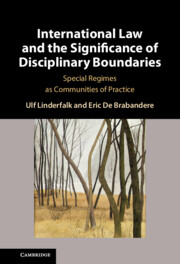 International Law and the Significance of Disciplinary Boundaries
International Law and the Significance of Disciplinary Boundaries Book contents
- International Law and the Significance of Disciplinary Boundaries
- International Law and the Significance of Disciplinary Boundaries
- Copyright page
- Contents
- Author Notes
- Abbreviations
- 1 The Concept of a Special Regime
- 2 Special Regimes as Communities of Practice
- 3 A Mutual Engagement
- 4 A Joint Enterprise
- 5 A Shared Repertoire
- 6 Special Regimes and the Fragmentation of International Law
- List of Sources
- Index
1 - The Concept of a Special Regime
Published online by Cambridge University Press: 21 November 2024
- International Law and the Significance of Disciplinary Boundaries
- International Law and the Significance of Disciplinary Boundaries
- Copyright page
- Contents
- Author Notes
- Abbreviations
- 1 The Concept of a Special Regime
- 2 Special Regimes as Communities of Practice
- 3 A Mutual Engagement
- 4 A Joint Enterprise
- 5 A Shared Repertoire
- 6 Special Regimes and the Fragmentation of International Law
- List of Sources
- Index
Summary
A special regime is a subpart of the international legal system. This is why, in international legal discourse, there are several different conceptions of a special regime. For the same reason as lawyers disagree about the proper definition of the concept of international law, not only do they have different conceptions of an international legal system but they also assume different definitions of the concept of a special regime. There are considerable differences among the different conceptions of a special regime. This observation raises questions about their relative utility. Chapter 1 suggests the adoption of the conception that characterizes special regimes as communities of practice – as it helps to manage and control the effect of legal fragmentation compared to other conceptions.
Keywords
- Type
- Chapter
- Information
- International Law and the Significance of Disciplinary BoundariesSpecial Regimes as Communities of Practice, pp. 1 - 22Publisher: Cambridge University PressPrint publication year: 2024
